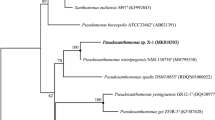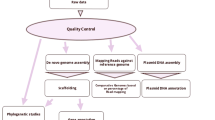Abstract
Pseudomonas sp. CTN-4 degrades chlorothalonil (CTN) but not acetamiprid (AAP), and Pigmentiphaga sp. strain AAP-1 degrades AAP but not CTN. A functional strain, AC, was constructed through protoplast fusion of two parental strains (Pseudomonas sp. CTN-4 and Pigmentiphaga sp. strain AAP-1) in order to simultaneously improve the degradation efficiency of AAP and CTN. Fusant-AC with eight transfers on plates containing two antibiotics and CTN was obtained. For the purpose of identifying and confirming the genetic relationship between fusant-AC and its parents, randomly amplified polymorphic DNA (RAPD), scanning electron microscopy (SEM), and 16S ribosomal DNA (rDNA) analysis were performed. In toto, RAPD fingerprint analysis produced 194 clear bands with 9 primers, which not only had bands in common with strains CTN-4 and AAP-1, but also had its own novel fusant-specific bands. The genetic similarity indices between fusant-AC and parental strains CTN-4 and AAP-1 were 0.40 and 0.69, respectively. The result of SEM indicated that the cell morphology of fusant-AC differed from both its parents. The fusant strain AC possesses a strong capability for AAP and CTN degradation. At AAP concentration (50–300 mg L−1), the degradation was achieved within 5 h. At the initial dose of 50 and 100 mg L−1 CTN, the percentages reached 96 and 91 % over a 36-h incubation period. The present study indicates that the protoplast-fusion technique may have possible applications in environmental pollution control.







Similar content being viewed by others
References
Ajithkumar B, Ajithkumar VP, Iriye R (2003) Degradation of 4-amylphenol and 4-hexylphenol by a new activated sludge isolate of Pseudomonas veronii and proposal for a new subspecies status. Res Microbiol 154(1):17–23
Bidlan R, Manonmani H (2002) Aerobic degradation of dichlorodiphenyltrichloroethane (DDT) by Serratia marcescens DT-1P. Process Biochem 38(1):49–56
Brunet JL, Badiou A, Belzunces LP (2005) In vivo metabolic fate of [14C]-acetamiprid in six biological compartments of the honeybee, Apis mellifera L. Pest Manag Sci 61(8):742–748
Caux PY, Kent R, Fan G, Stephenson G (1996) Environmental fate and effects of chlorothalonil: a Canadian perspective. Crit Rev Env Sci Tec 26(1):45–93
Chakraborty U, Sikdar SR (2008) Production and characterization of somatic hybrids raised through protoplast fusion between edible mushroom strains Volvariella volvacea and Pleurotus florida. World J Microb Biot 24(8):1481–1492
Chen T, Dai YJ, Ding JF, Yuan S, Ni JP (2008) N-demethylation of neonicotinoid insecticide acetamiprid by bacterium Stenotrophomonas maltophilia CGMCC 1.1788. Biodegradation 19(5):651–658
Chen K, Liu XM, Li R, Liu Y, Hu H, Li SP, Jiang JD (2011) Isolation of a buprofezin co-metabolizing strain of Pseudomonas sp. DFS35-4 and identification of the buprofezin transformation pathway. Biodegradation 22(6):1135–1142
Chen S, Dong YH, Chang C, Deng Y, Zhang XF, Zhong G, Song H, Hu M, Zhang LH (2013) Characterization of a novel cyfluthrin-degrading bacterial strain Brevibacterium aureum and its biochemical degradation pathway. Bioresour Technol 132:16–23
Cox C (1997) Chlorothalonyl. J Pest Reform 17:14–20
Dai YJ, Ji WW, Chen T, Zhang WJ, Liu ZH, Ge F, Yuan S (2010) Metabolism of the neonicotinoid insecticides acetamiprid and thiacloprid by the yeast Rhodotorula mucilaginosa strain IM-2. J Agr Food Chem 58(4):2419–2425
Fang H, Wang Y, Gao C, Yan H, Dong B, Yu Y (2010) Isolation and characterization of Pseudomonas sp. CBW capable of degrading carbendazim. Biodegradation 21(6):939–946
Feng L, Xiong M, Cheng X, Hou N, Li C (2013) Construction and analysis of an intergeneric fusant able to degrade bensulfuron-methyl and butachlor. Biodegradation 24(1):47–56
Hashimoto S, Aritomi K, Minohara T, Nishizawa Y, Hoshida H, Kashiwagi S, Akada R (2006) Direct mating between diploid sake strains of Saccharomyces cerevisiae. Appl Microbiol Biot 69(6):689–696
Jeong JJ, Kim JH, Kim CK, Hwang I, Lee K (2003) 3-and 4-alkylphenol degradation pathway in Pseudomonas sp. strain KL28: genetic organization of the lap gene cluster and substrate specificities of phenol hydroxylase and catechol 2, 3-dioxygenase. Microbiology 149(11):3265–3277
Katayama A, Ukai T, Nomura K, Kuwatsuka S (1992) Formation of a methylthiolated metabolite from the fungicide chlorothalonil by soil bacteria. Biosci Biotech Bioch 56(9):1520–1521
Kim OS, Cho YJ, Lee K, Yoon SH, Kim M, Na H, Park SC, Jeon YS, Lee JH, Yi H (2012) Introducing EzTaxon-e: a prokaryotic 16S rRNA gene sequence database with phylotypes that represent uncultured species. Int J Syst Evol Micr 62(3):716–721
Li J, Liu J, Shen W, Zhao X, Hou Y, Cao H, Cui Z (2010) Isolation and characterization of 3,5,6-trichloro-2-pyridinol-degrading Ralstonia sp. strain T6. Bioresour Technol 101(19):7479–7483
Liang B, Wang G, Zhao Y, Chen K, Li S, Jiang J (2011) Facilitation of bacterial adaptation to chlorothalonil-contaminated sites by horizontal transfer of the chlorothalonil hydrolytic dehalogenase gene. Appl Environ Microb 77(12):4268–4272
Lu J, Guo C, Zhang M, Lu G, Dang Z (2014) Biodegradation of single pyrene and mixtures of pyrene by a fusant bacterial strain F14. Int Biodeter Biodegr 87:75–80
Mateu-Sanches M, Moreno M, Arrebola FJ, Vidal JLM (2003) Analysis of acetamiprid in vegetables using gas chromatography-tandem mass spectrometry. Anal Sci 19(5):701–704
Mehling A, Wehmeier UF, Piepersberg W (1995) Nucleotide sequences of streptomycete 16S ribosomal DNA: towards a specific identification system for streptomycetes using PCR. Microbiology 141(9):2139–2147
Nei M, Li WH (1979) Mathematical model for studying genetic variation in terms of restriction endonucleases. P Natl Acad Sci 76(10):5269–5273
Phugare SS, Jadhav JP (2015) Biodegradation of acetamiprid by isolated bacterial strain Rhodococcus sp. BCH2 and toxicological analysis of its metabolites in silkworm (Bombax mori). Clean–Soil Air Water 43(2):296–304
Sanyal D, Chakma D, Alam S (2008) Persistence of a neonicotinoid insecticide, acetamiprid on chili (Capsicum annum L.). B Enviro Contam Tox 81(4):365–368
Savitha S, Sadhasivam S, Swaminathan K (2010) Regeneration and molecular characterization of an intergeneric hybrid between Graphium putredinis and Trichoderma harzianum by protoplasmic fusion. Biotechnol Adv 28(3):285–292
Sheng X, Liu F, Zhu Y, Zhao H, Zhang L, Chen B (2008) Production and analysis of intergeneric somatic hybrids between Brassica oleracea and Matthiola incana. Plant Cell Tiss Org 92(1):55–62
Shi X, Guo R, Takagi K, Miao Z, Li S (2011) Chlorothalonil degradation by Ochrobactrum lupini strain TP-D1 and identification of its metabolites. World J Microb Biot 27(8):1755–1764
Siglera WV, Turco RF (2002) The impact of chlorothalonil application on soil bacterial and fungal populations as assessed by denaturing gradient gel electrophoresis. Appl Soil Ecol 21(2):107–118
Suyama K, Yamamoto H, Tatsuyama K, Komada H (1991) Effect of long-term application of a fungicide, chlorothalonil, on cellulose decomposition and microflora in soil under upland conditions. J Pestic Sci 18(3):225–230
Takeo M, Prabu SK, Kitamura C, Hirai M, Takahashi H, D-i K, Negoro S (2006) Characterization of alkylphenol degradation gene cluster in Pseudomonas putida MT4 and evidence of oxidation of alkylphenols and alkylcatechols with medium-length alkyl chain. J Biosci Bioeng 102(4):352–361
Tamura K, Stecher G, Peterson D, Filipski A, Kumar S (2013) MEGA6: molecular evolutionary genetics analysis version 6.0. Mol Biol Evol 30:2725–2729
Tang H, Li J, Hu H, Xu P (2012) A newly isolated strain of Stenotrophomonas sp. hydrolyzes acetamiprid, a synthetic insecticide. Process Biochem 47(12):1820–1825
Tomizawa M, Yamamoto I (1993) Structure-activity relationships of nicotinoids and imidacloprid analogs. J Pestic Sci 18(1):91–98
Tomizawa M, Lee DL, Casida JE (2000) Neonicotinoid insecticides: molecular features conferring selectivity for insect versus mammalian nicotinic receptors. J Agr Food Chem 48(12):6016–6024
Toyama T, Maeda N, Murashita M, Chang Y-C, Kikuchi S (2010) Isolation and characterization of a novel 2-sec-butylphenol-degrading bacterium Pseudomonas sp. strain MS-1. Biodegradation 21(2):157–165
Wang G, Li R, Li S, Jiang J (2010a) A novel hydrolytic dehalogenase for the chlorinated aromatic compound chlorothalonil. J Bacteriol 192(11):2737–2745
Wang L, Pan Z-Y, Guo W-W (2010b) Proteomic analysis of leaves from a diploid cybrid produced by protoplast fusion between Satsuma mandarin and pummelo. Plant Cell Tiss Org 103(2):165–174
Wang GL, Wang L, Chen HH, Shen B, Li SP, Jiang JD (2011a) Lysobacter ruishenii sp. nov., a chlorothalonil-degrading bacterium isolated from a long-term chlorothalonil-contaminated soil. Int J Syst Evol Micr 61(3):674–679
Wang G, Liang B, Li F, Li S (2011b) Recent advances in the biodegradation of chlorothalonil. Curr Microbiol 63(5):450–457
Wang J, Hirai H, Kawagishi H (2012) Biotransformation of acetamiprid by the white-rot fungus Phanerochaete sordida YK-624. Appl Microbiol Biot 93(2):831–835
Wang G, Chen X, Yue W, Zhang H, Li F, Xiong M (2013a) Microbial degradation of acetamiprid by Ochrobactrum sp. D-12 isolated from contaminated soil. Plos One 8(12):e82603
Wang G, Yue W, Liu Y, Li F, Xiong M, Zhang H (2013b) Biodegradation of the neonicotinoid insecticide Acetamiprid by bacterium Pigmentiphaga sp. strain AAP-1 isolated from soil. Bioresour Technol 138:359–368
Wang G, Zhao Y, Gao H, Yue W, Xiong M, Li F, Zhang H, Ge W (2013c) Co-metabolic biodegradation of acetamiprid by Pseudoxanthomonas sp. AAP-7 isolated from a long-term acetamiprid-polluted soil. Bioresour Technol 150:259–265
Yang H, Wang X, Zheng J, Wang G, Hong Q, Li S, Li R, Jiang J (2013) Biodegradation of acetamiprid by Pigmentiphaga sp. D-2 and the degradation pathway. Int Biodeter Biodegr 85:95–102
Yoo YB, Lee KH, Kim BG (2002) Characterization of somatic hybrids with compatible and incompatible species by protoplast fusion in genera Pleurotus (Fr.) P. Karst. and Ganoderma P. Karst. by RAPD-PCR analysis. Int J Med Mushrooms 4(2)
Zhang Y, Lu J, Wu L, Chang A, Frankenberger WT (2007) Simultaneous removal of chlorothalonil and nitrate by Bacillus cereus strain NS1. Sci Total Environ 382(2):383–387
Zhao D, Wu B, Zhang Y, Jia H, Zhang X, Cheng S (2009) Identification of protoplast fusion strain Fhhh by randomly amplified polymorphic DNA. World J Microb Biot 25(7):1181–1188
Zhou LY, Zhang LJ, Sun SL, Ge F, Mao SY, Ma Y, Liu ZH, Dai YJ, Yuan S (2014) Degradation of the neonicotinoid insecticide acetamiprid via the N-carbamoylimine derivate (IM-1-2) mediated by the nitrile hydratase of the nitrogen-fixing bacterium Ensifer meliloti CGMCC 7333. J Agr Food Chem 62(41):9957–9964
Acknowledgments
This work was supported by grants from the Chinese National Natural Science Foundation (31100083, 31300422, and 41501304), the Foundation for Young Talents in College of Anhui Province, the Natural Science Foundation from Educational Commission of Anhui Province (KJ2015A049), Provincial Natural Science Foundation of Anhui (1508085MC49 and 1408085QC47), Scholar Backbone Supporting Plan of Huaibei Normal University, and Construction Project from College Scientific Research Innovation Team of Anhui Province—Ecological Restoration and Utilization of Coal Mining Subsidence Area.
Author information
Authors and Affiliations
Corresponding authors
Ethics declarations
Conflict of interest
The authors declare that they have no conflict of interest.
Additional information
Responsible editor: Robert Duran
Rights and permissions
About this article
Cite this article
Wang, G., Zhu, D., Xiong, M. et al. Construction and analysis of an intergeneric fusion from Pigmentiphaga sp. strain AAP-1 and Pseudomonas sp. CTN-4 for degrading acetamiprid and chlorothalonil. Environ Sci Pollut Res 23, 13235–13244 (2016). https://doi.org/10.1007/s11356-016-6482-y
Received:
Accepted:
Published:
Issue Date:
DOI: https://doi.org/10.1007/s11356-016-6482-y




